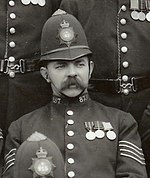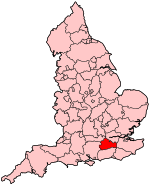St Martin of Tours church, Epsom
Church of England church buildings in SurreyDiocese of GuildfordEpsom and Ewell

St Martin of Tours church, Epsom is a Grade II* listed building, number 1028592, in Church Street, Epsom, Surrey, KT17 4PX. The flint tower dates from about 1450. The rest of the church was rebuilt in 1824 to designs by Mr Hatchard of Pimlico. In 1908 the choir and transepts were added by Sir Charles Nicholson. The organ is a fine three-manual Norman and Beard organ. There is a two-level reredos above the altar with small statues of saints. There are war memorials for the men of St Martin's Epsom who died in the Great War and to those who died in the Burma Campaign, 1942–45. The graveyard contains some fine monuments.
Excerpt from the Wikipedia article St Martin of Tours church, Epsom (License: CC BY-SA 3.0, Authors, Images).St Martin of Tours church, Epsom
Grove Road, Epsom and Ewell Woodcote
Geographical coordinates (GPS) Address External links Nearby Places Show on map
Geographical coordinates (GPS)
| Latitude | Longitude |
|---|---|
| N 51.33085 ° | E -0.25898 ° |
Address
St Martin of Tours
Grove Road
KT17 4DL Epsom and Ewell, Woodcote
England, United Kingdom
Open on Google Maps










